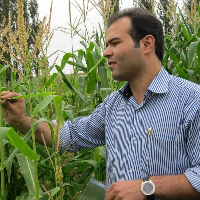The effect of Azotobacter, Azospirillum and compost along with chemical fertilizer on seed yield and nutrient uptake of common bean (Phaseolus vulgaris L.)
Author(s):
Article Type:
Research/Original Article (دارای رتبه معتبر)
Abstract:
Introduction
The common bean (Phaseolus vulgaris L.) is an important crop both in temperate and tropical climates and is an excellent source of protein. It is well established that depletion in nitrogen availability strongly affects rhizobial populations in the rhizosphere of legumes (Padilla et al., 2015). Nitrogen (N) is a major nutrient for plant growth and development and affects the seed yield more than other nutrients. Excessive application of nitrogen fertilizer increases nitrogen loss through leaching (water contamination) and sublimation (air pollution) (Zaidi et al., 2017). Biological fertilizers, which are a mixture of microorganisms, can be partial substitutes for chemical fertilizers. The ability of several bacterial species such as Azospirillum and Azotobacter in providing a large portion of the plants demanded nitrogen through biological fixation has been proven. Also, mushroom compost, which is one of the sideproducts of the edible fungus industry, can play an important role in increasing plant nitrogen uptake as a quality modifier. The present study is based on the assumption that the application of mushroom compost and biofertilizers can improve, in addition to seed yield, the seed quality of bean as compared to chemical nitrogen.Material and
Methods
A field experiment was conducted in Rasht, North of Iran, as factorial based on a randomized complete blocks design with three replications during the grown season 2015. The experimental factors consisted of chemical nitrogen (0, 75 and 150 kg urea ha1) and biological treatments (Azospirillum lipoferum, Azotobacter chroococcum, mushroom compost (2 t ha1), mushroom compost Azospirillum, mushroom compost Azotobacter and a control). A local cultivar of bean "Pach Baghala which was obtained from Guilan Agricultural and Natural Resources Research and Education Center was used in this experiment. The measured traits included chlorophyll content, the concentration of N and phosphorus (P) (root, shoot and seed) and potassium (K) of seed, yield components and seed yield. The statistical analysis was conducted using the SAS 9.2 software.Results And Discussion
The results showed that inoculation of the bean plant with the biological agents under all levels of chemical nitrogen fertilizer increased leaf chlorophyll content, number of pods per plant, number of seeds per plant and biological yield as compared to the control. Also, the application of biological treatments in the presence of 0, 75 and 150 kg of nitrogen raised bean seed yield by 19 63%, 10 74% and 5 65%, respectively, and the highest seed yield (3067 kg ha1) was obtained from Azospirillum mushroom compost treatment at 75 kg nitrogen ha1. Almost all the biological treatments used in this study led to decreased N and P concentrations of seed and shoot and K concentration of seed with increasing nitrogen fertilizer and the highest shoot N (3.82%), seed protein (30.93%), seed P (1.880%), seed K (1.96%) and protein yield (950 kg ha1) were observed with Azospirillum mushroom compost treatment. We found that when the bacteria, especially Azotobacter, were applied individually, they did not have a pronounced effect on the most of the traits of bean, but when used simultaneously with mushroom compost, they significantly augmented the plant nutrient uptake and seed yield. The Azospirillum, both individually and in combination with compost resulted in more bean N and P uptake, biological and seed yield than Azotobacter. Under the inoculation of biological agents, bean plant, when supplied with 150 kg nitrogen ha-1, produced yield which was less than or equal to 75 kg nitrogen ha-1. Therefore, the use of mushroom compost in combination with biofertilizers can reduce the requirement of chemical nitrogen fertilizer by up to 50%. The use of growth promoting bacteria can induce greater allocation of dry matter to different plant organs, which may result in increased vegetative development, making it possible for plant to capture more light and consequently increase its photosynthetic rate, ultimately leading to enhanced grain yield (Chauhan and Bagyaraj, 2015)Conclusion
According to our results, application of Azospirillum mushroom compost (2 t ha-1) under 75 kg nitrogen ha-1 can be considered as one of the suitable treatments for obtaining the highest seed yield and quality in common bean in Rasht region.Keywords:
Chlorophyll , Organic fertilizer , PGPR , Phosphorus , Potassium , Protein
Language:
Persian
Published:
Journal of Applied Crop Research, Volume:30 Issue: 116, 2017
Pages:
10 to 20
magiran.com/p1816151
دانلود و مطالعه متن این مقاله با یکی از روشهای زیر امکان پذیر است:
اشتراک شخصی
با عضویت و پرداخت آنلاین حق اشتراک یکساله به مبلغ 1,390,000ريال میتوانید 70 عنوان مطلب دانلود کنید!
اشتراک سازمانی
به کتابخانه دانشگاه یا محل کار خود پیشنهاد کنید تا اشتراک سازمانی این پایگاه را برای دسترسی نامحدود همه کاربران به متن مطالب تهیه نمایند!
توجه!
- حق عضویت دریافتی صرف حمایت از نشریات عضو و نگهداری، تکمیل و توسعه مگیران میشود.
- پرداخت حق اشتراک و دانلود مقالات اجازه بازنشر آن در سایر رسانههای چاپی و دیجیتال را به کاربر نمیدهد.
In order to view content subscription is required
Personal subscription
Subscribe magiran.com for 70 € euros via PayPal and download 70 articles during a year.
Organization subscription
Please contact us to subscribe your university or library for unlimited access!


